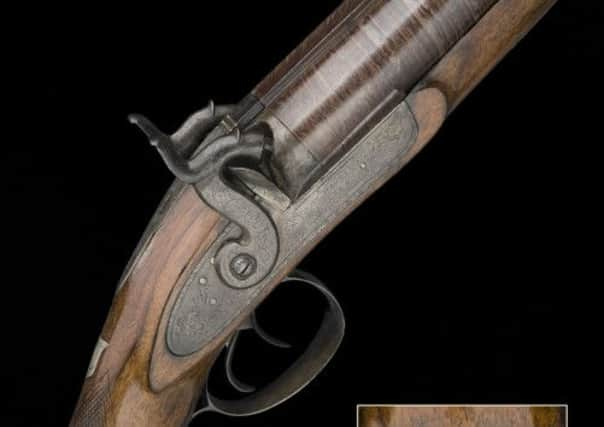Fist fighter Big Ben’s gun goes under the hammer


Known as ‘Big Ben’, he stood at 6ft 2in, weighed in at 18 stone and was such a formidable opponent that fighter after fighter put up to challenge him in the 19th century was duly beaten.
It is even reputed that London’s famous Big Ben, the bell in the Houses of Parliament clock tower, was named after him, as he was a favourite with MPs who would go to see him fight.
Advertisement
Hide AdAdvertisement
Hide AdNow a gun owned by a North Yorkshire collector but which once belonged to Benjamin Caunt is set to come up for auction in London, and is expected to sell for between £5,000 and £7,000.
Yesterday Nick Holt, of Holt’s Auctioneers, which is selling the gun, was at Orvis, a store in West Park, Harrogate, to host a gun valuation day.
“Benjamin Caunt was a Londoner and he was 6ft 2in and 18 stone, as you can imagine he was an absolute giant,” he said.
“He was a bare knuckle fighter and he made a great deal of money doing this.
Advertisement
Hide AdAdvertisement
Hide Ad“His nickname was ‘Big Ben’ and it’s thought that [the bell] Big Ben was named after him.
“This is a special gun because it was owned and used by Benjamin Caunt.”
Before the introduction of Marquis of Queensbury rules in 1867 fights could last for more than two hours – with rounds lasting as long as the opponents were able to stay on their feet.
Mr Caunt was heavyweight champion of England from 1838 until 1845, though he lost his title briefly in 1841 to Nick Ward but won it back the same year.
Advertisement
Hide AdAdvertisement
Hide AdThe fighter won his title in 1838 from William ‘Bendigo’ Thompson in a contest lasting more than 70 rounds.
In 1945 he relinquished his title to Thompson after a 96-round fight with a controversial verdict given by the referee, when it was alleged that Mr Caunt went down without a blow striking him.
He denied this but announced his retirement, only to return for a final attempt at the heavyweight crown 12 years later.
His final fight in 1857 was declared a draw when, after 60 rounds, Mr Caunt and his opponent were too exhausted to continue.
Advertisement
Hide AdAdvertisement
Hide AdMr Caunt’s gun, a mid-19th century six-bore double-barrelled percussion sporting gun, is thought to have been used by him in live pigeon matches, a forerunner to clay pigeon shooting.
A silver plaque on it is engraved with the words “Benjamin Caunt, Champion of England”.
It will be auctioned by Holt’s in a sale at Princess Louise House, Hammersmith Road, London, on June 20.
Among the other items up for sale are a gun, owned by a former miner turned-businessman, which is engraved with a portrait of the late Baroness Thatcher and expected raise between £30,000 and £50,000 at the sale in June.
Advertisement
Hide AdAdvertisement
Hide AdMr Holt said yesterday there had already been a great deal of interest in the gun.
The 20-bore single trigger over and under sidelock ejector gun was completed in 1990.
The owner was a coal miner aged 18 who worked as a pitman at their Littleton Colliery near Cannock. He left after a year and later became a successful businessman and had the engraving of the former Prime Minster etched onto his gun, not because of his mining past, but because he believed her policies had helped him flourish.
A spokesman for Holt’s said: “In recognition of the economic climate that had enabled him to flourish, the vendor had a vignette of Baroness Thatcher engraved on the underside of the action, entrusting the task to Marcus Hunt.
Advertisement
Hide AdAdvertisement
Hide Ad“Ironically the day the gun passed into his hands was the day that Lady Thatcher (as she was then) resigned as leader of the party following intense pressure from her peers.”
Following his retirement from the ring, Benjamin Caunt became a publican, running the Coach & Horses Inn on St Martins Lane in London, and he also worked as a fight promoter.
He died at the age of 46 in 1861, in London, reportedly from a cold caught at a live pigeon match and was buried in his home village of Hucknall, Nottinghamshire.